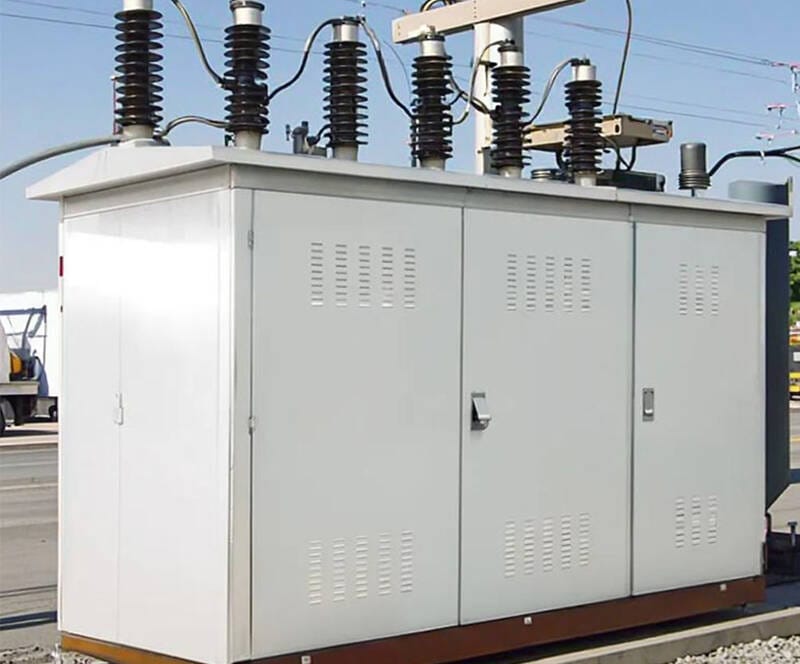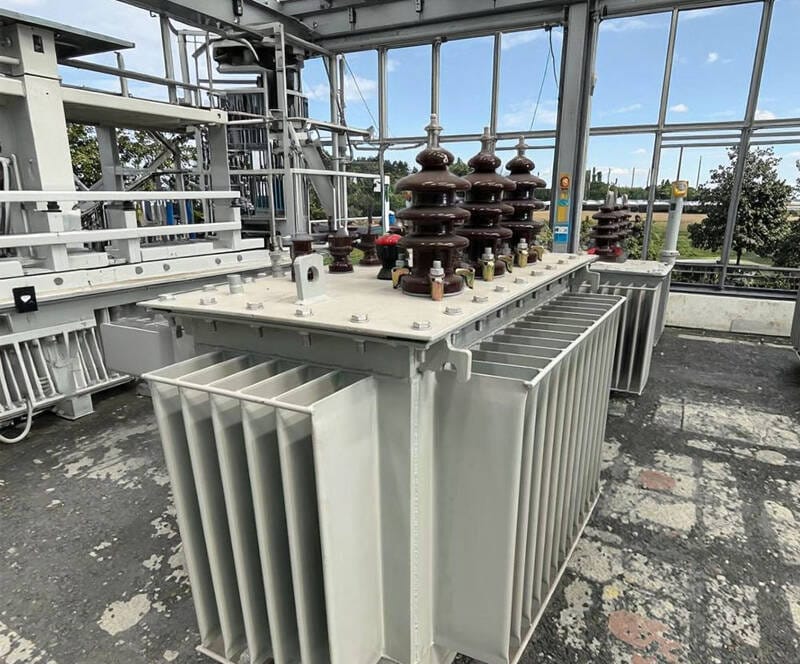Street lights, industrial motors, data centers, and sports stadiums—what do they all have in common? They require a constant and substantial supply of electricity to function effectively. However, accessing usable electricity isn’t as simple as connecting directly to high-voltage transmission lines. These lines carry electricity at voltages far too high for everyday applications. Before power can be safely used, it must be stepped down to a suitable level through a transformer.
Transformers are crucial devices in the power distribution system, yet many people are unfamiliar with how they function. Whether you’re planning to purchase a transformer or simply want to understand the basics, this article explains what transformers are, why they’re essential, how they operate, and the key components inside.
What Is a Transformer?
A transformer is a vital electrical device that enables the safe and efficient transfer of power across different parts of the energy network. At its core, it works by adjusting voltage levels between circuits—either stepping up the voltage for long-distance transmission or stepping down the voltage for safe distribution to factories, businesses, and homes.
Transformers play an essential role in modern power systems because electricity is most efficiently moved over high voltages but must be reduced to lower, usable levels before it can safely power equipment, machinery, or household appliances. By bridging this gap, transformers act as the silent backbone of power grids, ensuring that energy flows reliably from generation plants all the way to end users.
Why Is Voltage Conversion Necessary?
Electricity consists of two fundamental properties:
- Current – the rate of electrical flow, measured in amps
- Voltage – the force pushing the electrical flow, measured in volts
To simplify, think of electricity like water in a pipe:
- Current is the amount of water flowing
- Voltage is the water pressure
Power plants transmit electricity at extremely high voltages—often exceeding 300,000 volts—to minimize energy loss over long distances. However, this “electrical pressure” is too intense for direct use in homes or commercial buildings. Just like high-pressure water mains need pressure regulators before water enters your home, high-voltage electricity must be transformed to lower voltages.
This is where step-down transformers come into play. They reduce high transmission voltages to safer, usable levels at the point of consumption. These range from:
- Substation transformers used by utilities
- Pad-mounted transformers outside commercial building
- Pole-mounted transformers installed on utility poles
While residential areas typically use single-phase transformers (for 120/240V supply), commercial and industrial facilities often rely on three-phase transformers delivering 208V or 480V power. In this article, we focus on three-phase distribution transformers.
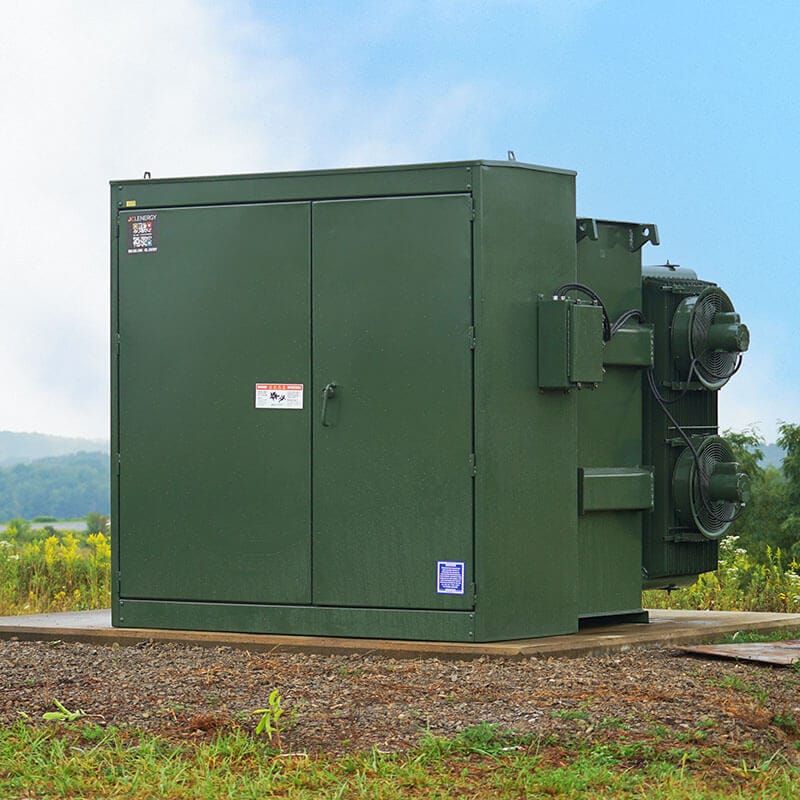
How Do Transformers Work?
Transformers work based on the principle of electromagnetic induction, first demonstrated by Michael Faraday. They transfer electrical energy between circuits via magnetic coupling—without a physical connection.
Rather than generating electricity, transformers change voltage levels to enable efficient and safe transmission. High-voltage operation reduces losses over long distances, while lower voltages ensure safety for end-use in industrial, commercial, and residential settings.
The Principle of Electromagnetic Induction
Transformers operate on Faraday’s law of electromagnetic induction, which explains how a changing magnetic field can induce voltage in a conductor. This principle enables efficient AC voltage adjustment.
Here’s the basic process:
- Magnetic Field Generation: Alternating current in the primary winding produces a varying magnetic field.
- Magnetic Coupling: The core, typically made of laminated silicon steel, efficiently transfers this field to the secondary winding.
- Voltage Induction: The changing magnetic field induces an AC voltage in the secondary winding. The voltage level depends on the turns ratio of the coils.
The turns ratio determines the voltage transformation:

Where:
- Vp = primary voltage
- Vs = secondary voltage
- Np = number of turns in the primary coil
- Ns = number of turns in the secondary coil
A higher turns ratio in the primary coil steps down the voltage, while a higher ratio in the secondary coil steps it up.
Practical Example:
A transformer with a 25:1 turns ratio converts an input of 12,000 V to an output of 480 V. This step-down process enables efficient transmission and safe usage in industrial and commercial applications.
In summary, transformers use electromagnetic induction to enable high-voltage, low-loss power transmission over long distances, followed by safe voltage reduction for practical applications.
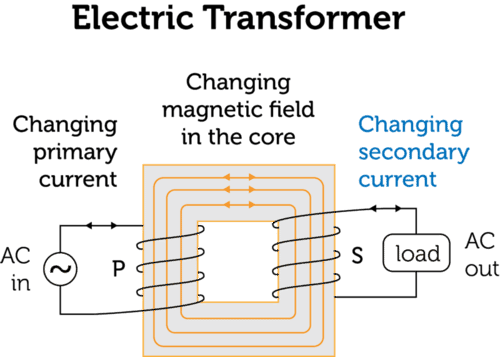
Transformer Coil Configurations
Transformers achieve voltage conversion through precisely arranged coil systems designed for both efficiency and operational reliability. A basic transformer includes two windings:
- Primary Coil: Draws electrical energy from the input source.
- Secondary Coil: Supplies the converted voltage to the connected load.
These windings are commonly constructed from copper or aluminum and are wound around a laminated iron core. The core guides magnetic flux to enhance energy transfer between coils while reducing losses. As the core repeatedly magnetizes and demagnetizes with AC current, it undergoes subtle physical vibrations—resulting in the characteristic hum of operating transformers.
Materials and Winding Design
- Copper Windings: Preferred for demanding applications due to superior conductivity, efficiency, and mechanical resilience.
- Aluminum Windings: Offer a balance of performance and economy, suitable where weight and cost are constraints.
- Winding Geometry: Layouts such as layered, disc-type, or helical are selected based on voltage rating, isolation needs, and thermal behavior.
Three-Phase Winding Arrangements
For high-power distribution, three-phase transformers employ specific interconnection strategies to maintain system balance:
- Delta (Δ) Connection: Windings are joined sequentially to form a closed circuit. This setup supports robust performance under high loads, tolerates phase faults, and is widely adopted in industrial settings.
- Wye (Y) Connection: One terminal of each coil connects to a shared neutral, enabling dual voltage outputs (line and phase). This versatility makes it well-suited for distribution grids requiring multiple service voltages.
Main Components of a Transformer
While there are many types—such as pad-mounted, pole-mounted, substation, and dry-type transformers—they share common structural elements. Here’s an overview of the major parts found in an oil-filled pad-mounted transformer:
1. Core
The transformer core, made of thin laminated silicon steel sheets, provides a highly effective magnetic path linking the primary and secondary windings. This laminated structure reduces eddy current and hysteresis losses, resulting in smoother magnetic coupling and significantly higher energy transfer efficiency.
2. Coils (Windings)
Within every transformer, precisely wound copper or aluminum conductors form the primary and secondary coils around the iron core. These windings are far more than simple loops of wire—they are meticulously designed to carry substantial electrical currents while offering optimal conductivity, thermal performance, and mechanical resilience.
Connected to the high-voltage input, the primary winding carries alternating current, producing a varying magnetic field within the core.
This magnetic field then intersects the secondary winding, where—through electromagnetic induction—a transformed voltage is generated, tailored to the needs of the load being supplied.
Material selection is critical to transformer performance:
- Copper windings excel in conductivity, mechanical robustness, and resistance to overload, and are often specified for heavy industrial applications.
- Aluminum windings provide a lightweight, economical alternative with sufficient performance for applications where cost efficiency is essential.
Through the synergy of these windings and the magnetic core, transformers achieve high energy efficiency, reduced losses, and extended operational life—qualities that cement their essential role in global power infrastructure.

3. Bushings
Insulation bushings are specialized fittings that allow electrical conductors to safely pass through the transformer tank. They provide a fully insulated path, preventing current leakage, safeguarding the internal insulating oil, and maintaining secure connections for both high and low voltage circuits under all operating conditions.
Constructed from durable materials such as porcelain, epoxy resin, or composite polymers, these bushings are designed to endure electrical stress, mechanical forces, and harsh environments, ensuring long-term safety and reliability in power distribution systems.
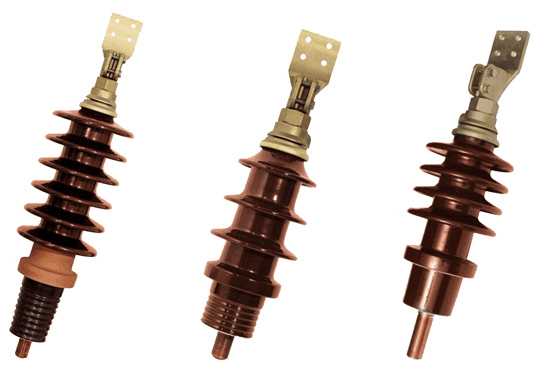
4. Fuses
Fuses serve as essential safety devices within the electrical system. When current rises beyond the designated safe limit, the fuse element automatically melts, breaking the circuit.
This quick interruption protects the transformer and connected equipment from potential overloads, short circuits, and costly damage.
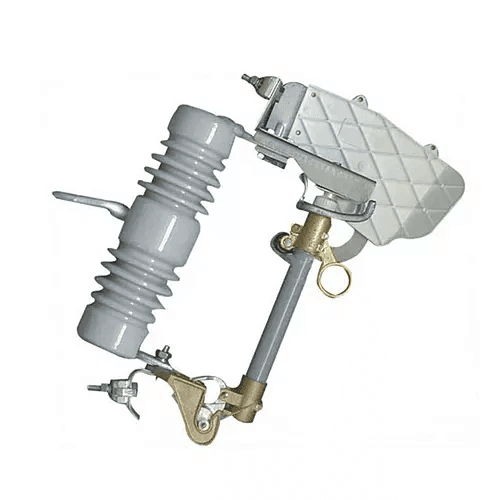
5. Voltage Taps
Voltage taps are access points integrated into a transformer’s primary winding, enabling operators to adjust the number of active turns in the coil. This allows precise regulation of the output voltage to align with grid conditions or load demand. A tap changer—either a manual switch or an automatic on-load mechanism in larger units—facilitates this adjustment.
By utilizing these taps, grid operators and facility managers can effectively respond to input voltage variations, seasonal load shifts, or voltage drops across long distribution lines. This ensures consistent and optimized voltage supply to downstream equipment.
6. Load Break Switch
This device is a rotary load-break switch, designed to safely disconnect the transformer from the live power grid. It enables operators to isolate the equipment even under electrical load, ensuring secure conditions for maintenance, preventing damage to components, and strengthening system-wide protection.
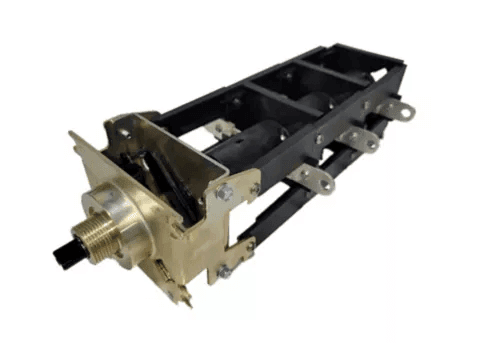
7. Transformer Fluid
Oil-immersed transformers utilize a high-grade insulating oil—either mineral-based or synthetic—that performs two essential roles: thermal management and electrical isolation. As the transformer operates, the oil flows around the active parts, absorbing heat caused by power losses and releasing it through the tank’s radiators or cooling fins. Simultaneously, it acts as a dielectric barrier, preventing arcs and short circuits between energized components.
The oil is contained within a sealed tank system that prevents exposure to humidity and contaminants. Enhanced external cooling surfaces facilitate efficient heat exchange with the ambient air. This integrated oil-based cooling and insulation system supports sustained operation under heavy loads and diverse environmental conditions, contributing to the transformer’s extended lifespan and operational reliability.
8. Gauges
Gauges are essential for real-time monitoring of transformer operating conditions. Standard instruments measure critical parameters including oil level, temperature, and internal pressure, offering operators early detection of abnormalities such as overheating, leaks, or gas buildup.
In larger or critical installations, these conventional gauges are often enhanced with digital monitoring systems. Equipped with sensors and remote communication features, these advanced systems continuously track performance, trigger alerts during irregularities, and can integrate with smart grid platforms to support predictive maintenance. This proactive approach improves operational safety and reliability while helping to extend the transformer’s service life.

9. Pressure Relief Device
This device functions as a pressure relief valve, engineered to shield the transformer from internal overpressure. In the event of abnormal operating conditions—such as extreme overheating or rapid gas generation—it automatically releases excess pressure in a controlled manner.
This action helps prevent catastrophic tank failure, protects adjacent equipment, and maintains the transformer’s operational safety and integrity.

10. Nameplate
Every transformer features a nameplate that acts as its unique technical identifier. It contains key operational specifications such as kVA rating, input and output voltages, number of phases, winding configuration, frequency, impedance, cooling class, and manufacturer information.
More than just an identification tag, the nameplate offers vital data required for proper installation, system compatibility assessment, and ongoing maintenance. By consulting these details, personnel can ensure the transformer is suited to its intended application, mitigate operational hazards, and adhere to relevant international standards.
In Summary
Transformers form the core of today’s electrical systems, enabling the safe and efficient transmission of electricity from generation sites to end users. Although they don’t generate power, they play an essential role in adapting electrical energy to suitable voltage levels for a vast range of uses—from low-voltage applications like residential electricity and home devices, to medium-voltage supply for commercial facilities, industrial plants, and healthcare centers, all the way to high-voltage requirements for stadium lighting, computing infrastructure, and heavy equipment.
The existence of worldwide power grids would be impractical without transformers. They make long-distance transmission feasible through high-voltage operation with reduced losses, and then lower the voltage to levels safe for consumption. In this way, transformers perform as unsung protectors of the electrical network. They operate ceaselessly behind the scenes, shielding delicate devices, improving energy efficiency, and guaranteeing continuous and dependable electricity supply.
For professionals such as engineers, energy managers, and business operators, comprehending transformer functionality goes beyond theory—it supports the development of energy-efficient designs, lowers operational expenses, and helps create robust power systems. And for the general public, transformers represent the often-unseen technology that supports daily life—from powering personal electronics to maintaining critical equipment in hospitals—all made possible by their quiet, unwavering performance.

Need help choosing the right transformer for your project?
Contact our team today for expert guidance and tailored solutions.

